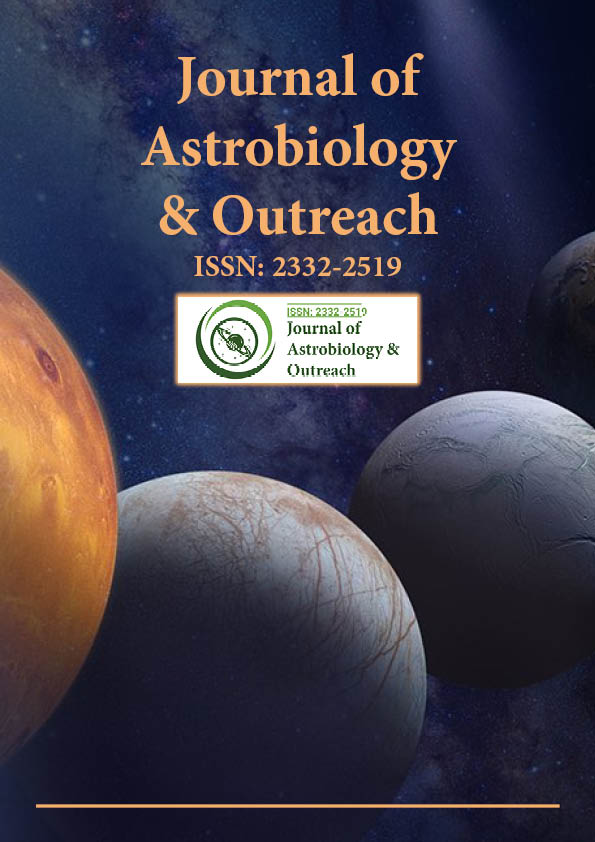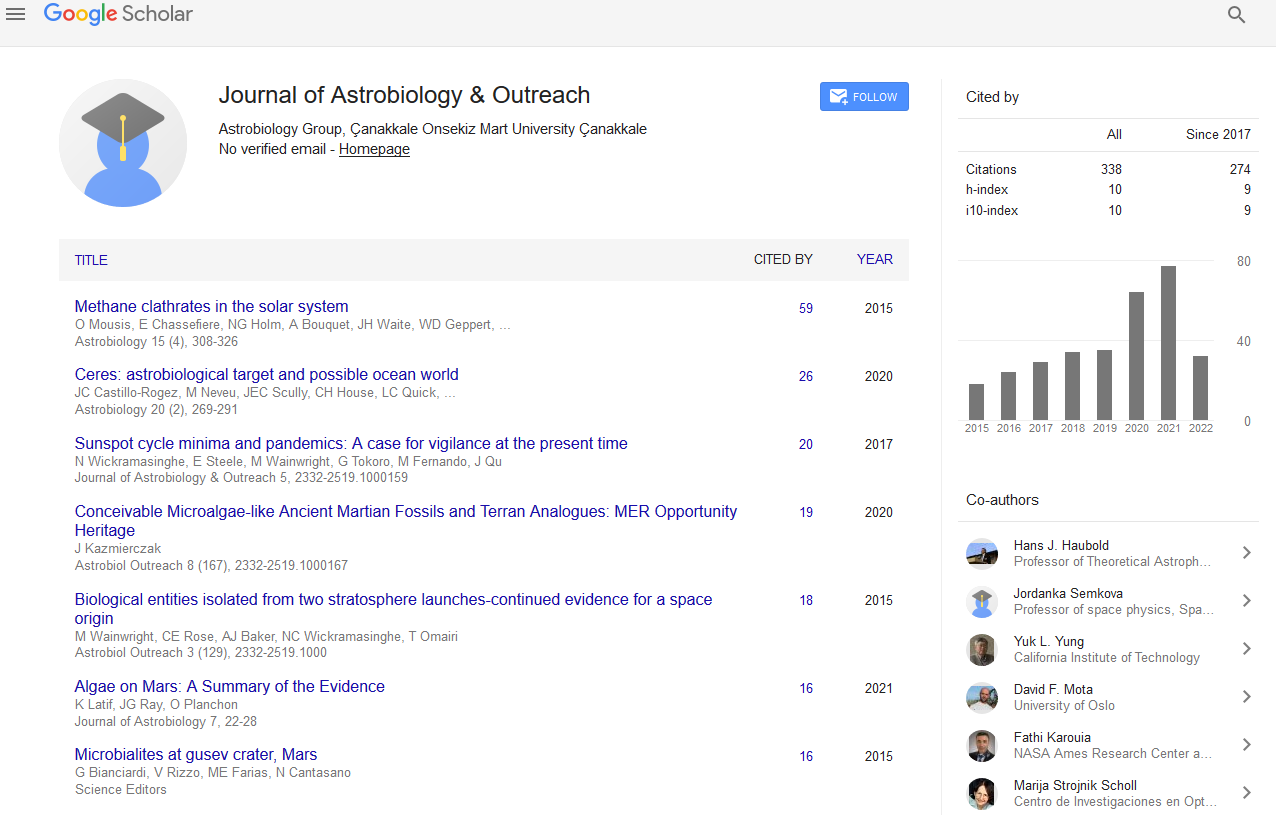Indexed In
- Open J Gate
- Academic Keys
- JournalTOCs
- RefSeek
- Hamdard University
- EBSCO A-Z
- OCLC- WorldCat
- Google Scholar
Useful Links
Share This Page
Journal Flyer

Open Access Journals
- Agri and Aquaculture
- Biochemistry
- Bioinformatics & Systems Biology
- Business & Management
- Chemistry
- Clinical Sciences
- Engineering
- Food & Nutrition
- General Science
- Genetics & Molecular Biology
- Immunology & Microbiology
- Medical Sciences
- Neuroscience & Psychology
- Nursing & Health Care
- Pharmaceutical Sciences
Perspective - (2024) Volume 12, Issue 3
Tracing Cosmic Origins: The Isotopic Connection between IIG and IIAB Iron Meteorites
Isabella Rossi*Received: 30-Aug-2024, Manuscript No. JAO-24-27917; Editor assigned: 02-Sep-2024, Pre QC No. JAO-24-27917 (PQ); Reviewed: 16-Sep-2024, QC No. JAO-24-27917; Revised: 23-Sep-2024, Manuscript No. JAO-24-27917 (R); Published: 30-Sep-2024, DOI: 10.35248/2332-2519.24.12.358
Description
Iron meteorites provide valuable insights into the formation and differentiation of planetary bodies in the early solar system. Among them, groups IIG and IIAB have drawn the attention of scientists due to their unique compositions and enigmatic origins. Recent isotopic evidence suggesting a common parent body for these two groups has opened new methods for understanding the processes that formed the solar system’s building blocks. This perspective explores into the implications of such findings, highlighting their relevance to planetary science and cosmochemistry.
Iron meteorites, classified into groups based on their elemental compositions and isotopic characteristics, are remnants of differentiated planetary cores that formed during the early stages of solar system evolution. The IIAB group is characterized by high nickel content and a wide range of trace element concentrations, indicative of extensive fractional crystallization in a metallic core. In contrast, IIG meteorites are rich in phosphorus and lack the diverse trace element patterns seen in IIAB, suggesting different formation or evolutionary conditions. Despite these apparent differences, isotopic studies, particularly those focusing on nucleosynthetic anomalies in isotopes like Molybdenum (Mo) and Tungsten (W), have revealed remarkable similarities between the two groups.
The isotopic congruence between IIG and IIAB iron meteorites supports the hypothesis of a common parent body—a single differentiated asteroid that underwent complex thermal and chemical processes. Such a scenario implies that the parent body experienced partial melting, leading to the segregation of metal and silicate phases, with subsequent crystallization of the metallic core giving rise to unique reservoirs from which IIG and IIAB meteorites originated. The observed isotopic uniformity suggests that these reservoirs retained a shared isotopic signature despite their unique geochemical pathways.
This common origin hypothesis has significant implications for our understanding of asteroid differentiation and the variability of meteorite groups. It challenges the traditional view that each iron meteorite group represents a unique parent body, instead emphasizing the potential for multiple groups to originate from different regions or stages of a single body’s evolution. This perspective reforms our interpretation of the early solar system’s dynamics, highlighting the role of localized processes, such as impact-induced mixing or thermal gradients, in generating the observed diversity of meteorites.
Furthermore, the isotopic link between IIG and IIAB meteorites provides a valuable benchmark for studying the chronology of planetary differentiation. By combining isotopic data with radiometric dating techniques, scientists can reconstruct the timeline of core formation, cooling and crystallization for the parent body. Such reconstructions provide insights into the timescales of metal-silicate differentiation, the thermal evolution of planetesimals and the influence of short-lived radionuclides like 26Al in driving early heating.
The implications of a shared parent body extend beyond planetary science to major questions about the nature of differentiation and evolution in small bodies. For example, the co-existence of IIG and IIAB meteorites suggests that the parent body experienced a complex history of partial melting and crystallization, likely influenced by early accretion and radiogenic heating. This raises questions about the extent to which such processes were common among early planetesimals and whether similar evolutionary pathways could explain the origin of other iron meteorite groups.
Moreover, the study of isotopic relationships in meteorites links the gap between laboratory-based analyses and astronomical observations. By linking isotopic signatures in meteorites to the compositional diversity observed in asteroids, scientists can refine models of asteroid formation and differentiation. This connection improves our ability to interpret data from spacecraft missions, such as NASA’s Psyche mission, which aims to study a metallic asteroid that may share characteristics with the parent body of iron meteorites.
In conclusion, the isotopic evidence for a common parent body of IIG and IIAB iron meteorites represents a change towards our understanding of solar system evolution. It highlights the complex exchange between differentiation, impact processes and isotopic inheritance in forming the variety of meteoritic materials. By uncovering the shared history of these meteorite groups, scientists gain valuable insights into the early stages of planetary formation and the mechanisms that controlled the evolution of small bodies. These findings highlight the importance of isotopic studies as a tool for decoding the solar system’s history, providing a foundation for future research into the origins and evolution of planetary materials.
Citation: Rossi I (2024). Tracing Cosmic Origins: The Isotopic Connection between IIG and IIAB Iron Meteorites. J Astrobiol Outreach. 12:358.
Copyright: © 2024 Rossi I. This is an open-access article distributed under the terms of the Creative Commons Attribution License, which permits unrestricted use, distribution, and reproduction in any medium, provided the original author and source are credited.

